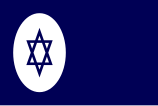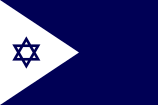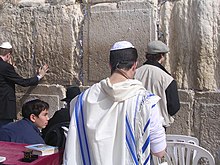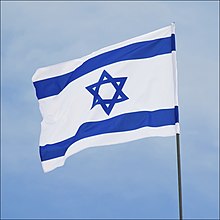Flag of Israel
 | |
| Flag of Zion | |
| Use | National flag |
|---|---|
| Proportion | 8:11 |
| Adopted | August 1897 (by the Zionist movement) 28 October 1948 (State of Israel) |
| Design | A blue Star of David between two horizontal blue stripes on a white field. |
 | |
| Use | Civil ensign |
| Proportion | 2:3 |
| Adopted | 1948 |
| Design | Navy blue flag with a white vertically elongated oval set near the hoist containing a vertically elongated blue Star of David. |
 | |
| Use | Naval ensign |
| Proportion | 2:3 |
| Adopted | 1948 |
| Design | Navy blue flag with a white triangle at hoist and blue Star of David in it. |
 | |
| Use | Israeli Air Force flag |
| Proportion | 2:3 |
| Design | Light blue flag with thin white stripes with dark blue borders near the top and bottom, displaying an air force roundel in the center. |
The flag of the State of Israel (
The blue color is described as "dark sky-blue",[1] and varies from flag to flag, ranging from a hue of pure blue, sometimes shaded almost as dark as navy blue, to hues about 75% toward pure cyan and shades as light as very light blue.[2] An early version of the flag was displayed in 1885 at a procession marking the third anniversary of Rishon LeZion. A similar version was designed for the Zionist movement in 1891. The Star of David (Magen David, מָגֵן דָּוִד), a Jewish symbol dating from late medieval-era Prague, was adopted by the First Zionist Congress in 1897.[1]
Origin of the flag
In the Middle Ages, mystical powers were attributed to the pentagram and hexagram, which were used in talismans against evil spirits. Both were called the "Seal of Solomon", but eventually the name became exclusive to the pentagram, while the hexagram became known as a "Magen David", or "Shield of David". Later the star began to appear in Jewish art. In 1648, Ferdinand II permitted the Jews of Prague to fly a "Jewish flag" over their synagogue. This flag was red with a yellow Magen David in the middle.[3]
The idea that the blue and white colors were the national color of the Jewish people was voiced early on by Ludwig August von Frankl (1810–94), an Austrian Jewish poet. In his poem, "Judah's Colours", he writes:
Anlegt er, wenn ihn Andacht füllt |
He puts on, when prayer fills him, |
In 1885, the agricultural village of

In
In May 1948, the Provisional State Council asked the Israeli public to submit proposals for a flag and they received 164 entries. Initially the council had wished to abandon the traditional design of the Zionist flag and create something completely different in order to prevent Jews around the world being charged with dual loyalty when displaying the Zionist flag, which could create the impression they are flying the flag of a foreign country.
Colours
Color scheme |
Blue | White |
|---|---|---|
| Pantone | 286 C |
White
|
| RGB | 0/56/184 |
255/255/255
|
| Hexadecimal | #0038b8 |
#FFFFFF
|
| CMYK | 100/70/0/28 |
0/0/0/0
|
Interpretation of colors

| Scheme | Textile color |
|---|---|
| White | Chesed (Divine Benevolence)[18] |
| Blue | It symbolizes God's Glory, purity and Gevurah (God's severity)[19][20] |
The blue stripes are intended to symbolize the stripes on a
The
In the Bible, the Israelites are commanded to have one of the threads of their tassels (tzitzit) dyed with tekhelet; "so that they may look upon it, and remember all the commandments of the LORD, and do them" (Num 15:39). Tekhelet corresponds to the color of the divine revelation (Midrash Numbers Rabbah xv.). Sometime near the end of the Talmudic era (500–600 CE) the industry that produced this dye collapsed. It became rarer; over time, the Jewish community lost the tradition of which species of shellfish produced this dye. Since Jews were then unable to fulfil this commandment, they have since left their tzitzit (tallit strings) white. However, in remembrance of the commandment to use the tekhelet dye, it became common for Jews to have blue or purple stripes woven into the cloth of their tallit.[22]
Criticism
Based on the boundaries of the Promised Land given in the Book of Genesis,[25] Palestinians including Yasser Arafat and Hamas have claimed that the two blue stripes on the Israeli flag represent the Nile and Euphrates rivers and allege that Israel desires to eventually seize all the land in between.[26][27][28][29] The Hamas Covenant states "After Palestine, the Zionists aspire to expand from the Nile to the Euphrates," and in 2006, Hamas leader Mahmoud al-Zahar issued a demand for Israel to change its flag, citing the "Nile to Euphrates" issue.[30] Responding to these claims, Arab writer Saqr Abu Fakhr wrote that the "Nile to Euphrates" claim is a popular misconception about Jews that, despite being unfounded and having abundant evidence refuting them, continues to circulate in the Arab world.[31]

Criticism from
Notable flags

- The " in 1945. Like the latter photograph, the Ink Flag raising has also been reproduced as a memorial.
- The Israeli flag that stayed flying throughout the siege of Bar-Lev Lineto remain in Israeli hands during the war.
- The 2007 World Record Flag, which was unveiled at an airfield near the historic mountain fortress of Filipino entrepreneur and Evangelical Christian Grace Galindez-Gupana as a religious token and diplomatic gesture of support for Israel.[43] In the Philippines, churches often display the Israeli flag.[44] This record has since been surpassed several times.[45]
See also
- Blue in Judaism
- List of national symbols of Israel
- Flag of the British Mandate of Palestine
- Flag of Northern Cyprus
- Karamanid flag
- List of flags of Israel
- Dance of Flags
References
- ^ a b Israel Ministry of Foreign Affairs publication The Flag and the Emblem Archived 2007-04-17 at the Wayback Machine by art historian Alec Mishory, wherein he quotes "The Provisional Council of State Proclamation of the Flag of the State of Israel" made on 28 October 1948 by Joseph Sprinzak, Speaker.
- ^ Varied examples Archived 2006-07-09 at the Wayback Machine; Flag ~75% toward cyan from pure blue full article: The Flag and the Emblem Retrieved 28 July 2006.
- ^ How Israel Got Its Flag and What It Means, Haaretz
- ISBN 9783598507816.)
{{cite book}}: CS1 maint: location missing publisher (link - ^ Bar-Am, Aviva (26 April 2002). "The first families". The Jerusalem Post. Archived from the original on 18 October 2016.
- ^ Father of Dora Askowith. See Miller, Adinah S. "Dora Askowith". Shalvi/Hyman Encyclopedia of Jewish Women. 31 December 1999. Jewish Women's Archive. Retrieved 9 April 2023.
- ^ Reznikoff, Charles (May 1953). "From the American Scene: Boston's Jewish Community: Earlier Days". Commentary. Retrieved 3 November 2017.
- ^ Herzl, Theodor (1896). "Der Judenstaat. Versuch einer modernen Lösung der Judenfrage" (in German). Leipzig u. a. – via Deutsches Textarchiv.
- ^ Sholem, Gershom (September 1949). "The Curious History of the Six Pointed Star; How the 'Magen David' Became the Jewish Symbol". Commentary. pp. 243–251. Retrieved 19 November 2013.
- ^ Mazur, Edward (2021). "Flags of the forefathers and foremothers" (PDF). Chicago Jewish Historical Society. Retrieved 28 December 2023.
Bein, who in 1955 was appointed by Prime Minister David Ben Gurion as the Keeper of the Israel National Archives, ... claimed that David Wolffsohn, Herzl's successor as president of the Zionist Congress, had been the first to come up with the idea of a blue-and white flag. "One of the many problems with which I had to deal," Wolffsohn wrote in his reminiscences, from which Bein would quote at length and from which Weissman Joselit recounted in her Forward article, "was that of deciding with which flag we should drape the hall. The question troubled me considerably. We would obviously have to create a flag, since we had none … Suddenly, I got a brainwave: We already had a flag—the blue and white of the tallith … We had but to unfurl it before the eyes of the Jewish people and the world at large!"
- U.S. Department of State.
- Jewish Encyclopedia, 1911
- ^ Underwood, Underwood and (1904), English: Title: "From tower of Electricity Building, northeast over Basin and Plaza to Manufactures Building, World's Fair, St. Louis, USA". [Louisiana Purchase Exposition]. U and U 48., retrieved 4 December 2022
- ^ J. Boas: German–Jewish Internal Politics under Hitler 1933–1938 Archived 2004-09-27 at the Wayback Machine, in: Leo Baeck Institute Yearbook, 1984, pp3–25
- ^ "German Press Advises Jews Not to Fly Zionist Flag" (Press release). Jewish Telegraphic Agency. 23 September 1936.
- ISBN 978-0-520-04817-1.
Moshe Sharett argued on behalf of the government that the proposed flag for the new state must be distinct from the Zionist flag. He explained that otherwise it would embarrass Diaspora Jews who "fly the flag of the world Jewish people – the Zionist flag" but who, understandably enough, would not want to fly the flag of the State of Israel.
- ISBN 978-90-04-40527-1.
- ^ a b "Why the Tallit Barcode?". Chabad. Retrieved 13 November 2014.
- ^ a b Numbers Rabbah 14:3; Hullin 89a.
- ^ a b Exodus 24:10; Ezekiel 1:26; Hullin 89a.
- ^ Navon, Mois. "Historical Review of Tekhelet & the Hillazon" (PDF). Ptil Tekhelet Organization. Retrieved 18 September 2015.
- About.com. Archived from the originalon 20 September 2005. Retrieved 3 April 2006.
- ^ The National Committee for the Heads of the Arab Local Authorities in Israel (December 2006). "The Future Vision of Palestinian Arabs in Israel" (PDF). p. 7. Archived from the original (PDF) on 27 March 2009. Retrieved 30 April 2020.
- ^ "64 countries have religious symbols on their national flags". Pew Research Center. 25 November 2014.
- ^ Genesis 15.18: "The Lord made a covenant with Abram, saying unto thy seed have I given this land from the river of Egypt unto the great river, the River Euphrates."
- ^ Playboy Interview: Yasir Arafat, Playboy, September 1988.
ARAFAT: Yes, because they don't want it. Look at the slogans they use: that the land of Israel is from the Euphrates to the Nile. This was written for many years over the entrance to the Knesset, the parliament. It shows their national ambition—they want to advance to the Jordan River. One Israel for them, what's left for us... Do you know what the meaning of the Israeli flag is?
PLAYBOY: No.
ARAFAT: It is white with two blue lines. The two lines represent two rivers, and in between is Israel. The rivers are the Nile and the Euphrates. - ^ Rubin, Barry. The PLO between Anti-Zionism and Antisemitism, Background and Recent Developments Archived 2006-03-22 at the Wayback Machine, The Vidal Sassoon International Center for the Study of Antisemitism, The Hebrew University of Jerusalem, 1993. Retrieved 3 April 2006.
- ^ Rubinstein, Danny. Inflammatory legends, Haaretz, 15 November 2004. Retrieved 3 April 2006.
- Middle East Quarterly, March, 1994. Retrieved 3 April 2006.
- ^ Shiloh, Scott. Mofaz: Hamas Acting Responsibly; Hamas: Israel Must Change Flag, Arutz Sheva, 30 January 2006. Retrieved 3 April 2006.
- ^ Abu Fakhr, Saqr. "Seven Prejudices about the Jews", Al-Hayat, 12–14 November 1997.
- ISBN 978-1-107-01424-4. Retrieved 9 May 2013.
- ISBN 978-1-55266-171-0. Retrieved 16 August 2011.
- ^ Yakov Rabkin. Judaism vs Zionism in the Holy Land, A Threat from Within: A Century of Jewish Opposition to Zionism, Fernwood/Zed Books, 2006.
- ISBN 978-1-107-01424-4. Retrieved 9 May 2013.
Perhaps, the most prominent Sephardic legal authority, Rabbi Ovadia Yosef of Jerusalem, upholds Rabbi Feinstein's verdict and, in his comment, specifies that "those who chose this flag as a symbol of the State were evil-doers." Emphasizing that removing the flag, "a vain and useless object", from the synagogue should be done in harmony and peace, he recommends "uprooting all related to the flag so that it should not constitute a reminder of the acts of the evil-doers."
- ^ Shimy Dvar HaShem. 22 August 2014. p. 44.
- ISBN 978-1-4008-2557-8.
- ISBN 978-965-224-073-6.
Note 31: This display of flags stands in sharp contrast with the negative attitude of Israeli Haredim toward the Israeli flag, which consequently is never displayed on Israeli Haredi homes or businesses.
- ISBN 978-1-84545-062-5.
In contrast to other Haredi leaders of the time, he also turned to government sources to further his aims. He was therefore meticulous in making sure that the Israeli flag would be raised above the Yeshiva each Independence Day, a symbol of the modus vivendi he had reached with the Israeli government.
- ^ Matthew Wagner (3 May 2006). "Haredis indifferent to flag on yeshiva". The Jerusalem Post. Retrieved 30 April 2020.
- ISBN 978-1-4443-0793-1.
Many haredim or ultra-orthodox Jews believe that the state of Israel should not be considered legitimate until the messiah manifests himself. Hence, some anti-Zionist haredi factions practice the burning of the Israeli flag on Independence Day
- ^ Marcy Oster (13 May 2019). "NJ Restaurant says kosher certification at risk for flying Israeli flag". The Times of Israel. Retrieved 27 April 2020.
- ^ "Giant Israeli flag breaks world record for largest in world". Haaretz. Associated Press. 25 November 2007. Archived from the original on 6 January 2022. Retrieved 2 August 2014.
- ^ "Do Flags Belong in Churches? Pastors Around the World Weigh In". Christianity Today. 2 July 2021. Archived from the original on 3 July 2021.
- ^ "Largest flag flown". Guinness World Records. 28 March 2022.


